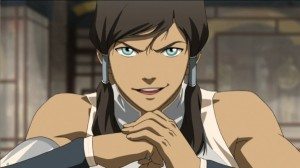The Legend of Korra finale
For those of you who are watching or intend to watch The Legend of Korra please move on to another article; everything from the first line of the next paragraph onwards is a spoiler. Like that line all in capitals. Look at it. That’s a spoiler. That’s how the series ends. Try to avoid those.
KORRASAMI IS CANON. The theme for the last month has been how Korra, as an animated television show aired on a children’s network (namely Nickelodeon), has pushed boundaries with representation. Korra and Asami, the two girls who were in a relationship with the same guy (Mako) during series one and two, walk off into a sunsetlike background hand in hand, staring deeply into each others eyes. So yeah, bisexuals exist in children’s television now. About fucking time.
For those of you worried about the gay agenda, welcome to hell. Children’s programming is starting to explicitly recognise the existence of nonheterosexual people, and ‘people’ is definitely the operative word here. Not caricatures where their sexuality defines their personality, but real, fleshedout characters, with interesting storyarcs and relationships, who aren’t straight.
And what Korra is doing for sexuality, Steven Universe is doing for gender. There’s an episode where Steven, our pudgy young hero, fuses through magical gem powers with his friend Connie. They morph into a large womanly looking person with no defined gender, at least certainly not defined as either “male” or “female”. So kids today are looking at their TV screens (or laptop screens or ipads or tablets or whatever ten year olds have under their control these days) and seeing programming that is telling them “it’s okay to not be a guy or a girl. It’s okay to not like guys or girls.”
I’ve written about sexuality in children’s programming, specifically Korra, before. It’s actually pretty much exclusively all I’ve written about because, hey, I can do that if I want. I also do it because I genuinely believe it to be the most important tool we have in fighting to be recognised. It shows kids that it’s okay to be incredibly, wildly different. It makes it powerful to be incredibly, wildly different. And kid’s are impressionable. You tell them it’s okay, they’ll go with it. You tell them it’s not, they’ll go with that too.
Ignoring these people, whether they’re people of colour, LGBTQIA+, disabled, or any number of oppressed groups, is saying that it’s better if they don’t exist. It’s saying that in the perfect world of children’s programmes, anomalies of humanity don’t have a place. That’s wrong, and it’s what we’re told everyday from the minute we understand language.
Originally, this article was supposed to be simply and absolutely about the Korra finale. And here’s a summary for you: there’s a purple beam, Kuvira (the villain) blows up a city, shit is flung fanwards, Korra saves the day with her team, stuff gets gay, the end. It’s great, fantastic, I thoroughly encourage you to watch it. But the half minute scene with Korra and Asami finally and canonically falling in love, that’s worth more to me than every minute of entertainment that’s been thrown my way by the Avatar group, and that is a big deal.
You grow up thinking there is no place in the world for you, that you’re utterly alone, that you’re different the way that spiders and centipedes are dif erent. You grow up alone when you’re not straight and not cis. And kids still waiting to discover Korra, or the mountain of programming it’ll hopefully inspire, they won’t. They’ll have Korra and Asami, they’ll have Steven and Connie, they’ll have people to relate to in ways that straight people have always taken for granted. That’s important. That’s beautiful.


Comments (2)